Physics[]
- See also: Wikisource:The Mathematical Principles of Natural Philosophy (1846) and *Galilean relativity
- Reality is what doesnt go away when you arent looking at it.
- Something is known Beyond a reasonable doubt if any doubt that it is true is unreasonable. A doubt is reasonable if it is consistent with the laws of cause and effect.
In the four rules, as they came finally to stand in the 1726 edition, Newton effectively offers a methodology for handling unknown phenomena in nature and reaching towards explanations for them.
- Rule 1: We are to admit no more causes of natural things than such as are both true and sufficient to explain their appearances.
- Rule 2: Therefore to the same natural effects we must, as far as possible, assign the same causes.
- Rule 3: The qualities of bodies, which admit neither intensification nor remission of degrees, and which are found to belong to all bodies within the reach of our experiments, are to be esteemed the universal qualities of all bodies whatsoever.
- Rule 4: In experimental philosophy we are to look upon propositions inferred by general induction from phenomena as accurately or very nearly true, not withstanding any contrary hypothesis that may be imagined, till such time as other phenomena occur, by which they may either be made more accurate, or liable to exceptions.
- The difference between the net kinetic energy and the net potential energy is called the “Lagrangian.”
- The action is defined as the time integral of the Lagrangian.
- The Hamiltonian is the sum of the kinetic and potential energies.
- *Noether's theorem states that every differentiable symmetry of the *action of a physical system has a corresponding *conservation law.
- Energy is conserved in relativity and proper velocity is proportional to momentum at all velocities.
Highly recommend:
- Thinking Physics Is Gedanken Physics by Lewis Carroll Epstein
- Understanding physics by Isaac Asimov
- The Feynman Lectures
Relativity[]
- Most confusion about relativity centers around a poor understanding of relativity of simultaneity.
- Since the length of an object is the distance from head to tail at one simultaneous moment, it follows that if two observers disagree about what events are simultaneous then they will also disagree on the length of objects.
- If a line of clocks appear synchronized to a stationary observer and appear to be out of sync to that same observer after accelerating to a certain velocity then it follows that during the acceleration the clocks ran at different speeds. Some may even run backwards. This line of reasoning leads to general relativity.
- The gravitational time dilation at any point in a gravity well is equal to the time dilation that an object falling to that point would experience due its velocity (which never reaches "c") alone.
There might be a loophole to the law that you can't travel faster than light: If the distance between the front of rocket and the back can be made zero then it's conceivable that it could travel faster than light.
Dimensional analysis[]
- See also: Natural units
Any physical law that accurately describes the real world must be independent of the units (e.g. km or mm) used to measure the physical variables.
Consequently, every possible commensurate equation for the physics of the system can be written in the form
The dimension, Dn, of a physical quantity can be expressed as a product of the basic physical dimensions length (L), mass (M), time (T), electric current (I), absolute temperature (Θ), amount of substance (N) and luminous intensity (J), each raised to a rational power.
Suppose we wish to calculate the *range of a cannonball when fired with a vertical velocity component and a horizontal velocity component , assuming it is fired on a flat surface.
The quantities of interest and their dimensions are then
- range as Lx
- as Lx/T
- as Ly/T
- g as Ly/T2
The equation for the range may be written:
Therefore
and we may solve completely as , and .
Atoms[]
- See also: Periodic table and Spatial_structure_of_the_electron
The first pair of electrons fall into the ground shell. Once that shell is filled no more electrons can go into it. Any additional electrons go into higher shells.
The nucleus however works differently. The first few neutrons form the first shell. But any additional neutrons continue to fall into that same shell which continues to expand until there are 49 pairs of neutrons in that shell.
- The highest energy gamma rays emitted by nuclei are around 10 Mev which corresponds to a wavelength of 124 fm.
The electric force between two electrons is 4.166 * 1042 times stronger than the gravitational force. (12,242 * 2128)
The energy required to assemble a sphere of uniform charge density =
- For Q=1 electron charge and r=1.8506 angstrom thats 4.669 ev. That energy is stored in the electric field of the electron.
- The energy per volume stored in an electric field is proportional to the square of the field strength so twice the charge has 4 times as much energy.
- 4*4.669 = 18.676.
Mass of electron = Me = 510,999 ev
Mass of proton = Mp = 938,272,000 ev
Mass of neutron = Mn = 939,565,000 ev
- Mn = Mp + Me + 782,300 ev
Mass of muon = Mμ = 105.658 ev = 206.7683 * Me
Mass of helium atom = 3,728,400,000 = 4*Me+4*Mp -52.31 Me
- The missing 52.31 electron masses of energy is called the mass deficit or nuclear binding energy. Fusing hydrogen into helium releases this energy.
Iron can be fused into heavier elements too but doing so consumes energy rather than releases energy.
The total outward force for a solid 4-dimensional sphere of uniform density in Clifford rotation is
The angular momentum of a solid 4-dimensional sphere of uniform density is
Empirically determined values for the size of atoms:
- Diatomic Hydrogen (Z=2) = 1.9002 angstroms
- Helium (Z=2) = 1.8506 angstroms
In 3 dimensions the force between 2 electrons is:
- where me is the electron's mass, e1 is the charge of the electron,
- Failed to parse (syntax error): {\displaystyle \varepsilon_0 = \frac{1}{180.95} \frac{e^2}{\text{eV} Å}}
- but in 4 dimensions:
- where r is the distance at which the inverse square law gives the same result as the inverse cube law. In other words, the distance at which the inverse square law of the macroscopic world gives way to the inverse cube law of the microscopic world.
The angular momentum is:
- where ħ is reduced Planck constant
- Therefore:
Density and thermal expansion[]
Densities:
- Crystalline solids: 1.2
- Amorphous solids: 1.1
- liquids: 1
Water ice is an exception. Ice has a density of 0.9167
From Wikipedia:Thermal expansion
Thermal expansion generally decreases with increasing bond energy, which also has an effect on the melting point of solids, so, high melting point materials are more likely to have lower thermal expansion. In general, liquids expand slightly more than solids. The thermal expansion of glasses is higher compared to that of crystals.
For an ideal gas, the volumetric thermal expansion (i.e., relative change in volume due to temperature change) depends on the type of process in which temperature is changed. Two simple cases are where the pressure is held constant (Isobaric process), or when the volume (Isochoric process) is held constant.
The derivative of the ideal gas law, , is
where is the pressure, is the specific volume, and is temperature measured in energy units.
By definition of an isobaric thermal expansion, we have , so that , and the isobaric thermal expansion coefficient is
- .
Similarly, if the volume is held constant, that is if , we have , so that the isovolumic thermal expansion is
- .
For a solid, we can ignore the effects of pressure on the material, and the volumetric thermal expansion coefficient can be written:
where is the volume of the material, and is the rate of change of that volume with temperature.
This means that the volume of a material changes by some fixed fractional amount. For example, a steel block with a volume of 1 cubic meter might expand to 1.002 cubic meters when the temperature is raised by 50 K. This is an expansion of 0.2%. If we had a block of steel with a volume of 2 cubic meters, then under the same conditions, it would expand to 2.004 cubic meters, again an expansion of 0.2%. The volumetric expansion coefficient would be 0.2% for 50 K, or 0.004% K−1.
If we already know the expansion coefficient, then we can calculate the change in volume
where is the fractional change in volume (e.g., 0.002) and is the change in temperature (50 °C).
For common materials like many metals and compounds, the thermal expansion coefficient is inversely proportional to the melting point. In particular for metals the relation is:
for halides and oxides
Quasiparticles[]
- See also: Wikipedia:List of quasiparticles and Wikipedia:Quasiparticle
A hole is a region with a net surplus of positive charges.
An anti-hole is a region with a net surplus of negative charges.
Electricity is the flow of holes and anti-holes.
A flow of positive charges gives the same electric current, and has the same effect in a circuit, as an equal flow of negative charges in the opposite direction. Since current can be the flow of either positive or negative charges, or both, a convention is needed for the direction of current that is independent of the type of charge carriers. The direction of conventional current is arbitrarily defined as the same direction as positive charges flow.[1]
A p-type semiconductor only conducts holes.
An n-type semiconductor only conducts anti-holes.
Holes and anti-holes combine at the junction of a forward biased diode.
- In the case of a light emitting diode the combining of electrons and holes results in the creation of light.
Electricity will not flow through a reverse biased diode because this would require holes and anti-holes to form at and move in opposite directions away from the junction.
- However, in the case of a photodiode, current can be induced to flow by shining a light on the junction.
A transistor can be thought of as two diodes placed end-to-end (i.e. in series). When there is a voltage drop between the collector and the emitter then one diode is forward biased and the other diode is reverse biased. Because one of the diodes is reverse biased current will not flow. However current will flow from the collector to the emitter when a small amount of current is allowed to pass through the base.
To understand why this happens it helps to imagine that the forward biased diode is a light emitting diode and the reverse biased diode is a photodiode. (Such a transistor is called a photon coupled transistor.) When current is allowed to pass through the base light is created by the light emitting diode. This light is then absorbed by the photodiode and therefore current is able to pass from collector to emitter. This in turn creates still more light which allows still more current to pass. If the photodiode absorbed 100% of the light emitted than the current would flow forever. Since not all the light created by the light emitting diode is absorbed by the photodiode the current will decay rapidly.
The total amount of current that flows from collector to emitter will be some multiple of the current that originally flowed through the base.
From Wikipedia:Exciton:
An exciton is a bound state of an electron and an electron hole which are attracted to each other by the electrostatic Coulomb force. It is an electrically neutral quasiparticle that exists in insulators, semiconductors and in some liquids. The wavefunction of the bound state is said to be hydrogenic, an exotic atom state akin to that of a hydrogen atom. However, the binding energy is much smaller and the particle's size much larger than a hydrogen atom. This is because of both the screening of the Coulomb force by other electrons in the semiconductor (i.e., its dielectric constant), and the small effective masses of the excited electron and hole. Provided the interaction is attractive, an exciton can bind with other excitons to form a biexciton, analogous to a dihydrogen molecule.
Tidal acceleration[]
- See also: Formation_of_the_Solar_System
Image shows an approximation of the shape (*Equipotentials) of a rapidly spinning planet. North pole is at the top. South pole is at the bottom. The equator reaches orbital velocity.
Orbital velocity:
Orbital period:
Orbital angular momentum:
Rotational angular momentum of solid sphere:
where:
- r is the orbit's semi-major axis
- G is the gravitational constant,
- M is the mass of the more massive body.
- m is the mass of the less massive body.
Moons orbital angular momentum is 28.73 * 10^33 Js
Earths rotational angular momentum is 7.079 * 10^33 Js
The total amount of angular momentum for the Earth-Moon system is 28.73 + 4.6 = 33.33 * 10^33 Js
Moons current orbit is 384,399 km. Its orbital period is 2.372 * 106 seconds. (27 days, 10 hours, 50 minutes). Its orbital velocity is 1.022 km/s.
*Roche limit for the moon is
- Fluid: 18,381 km fluid
- 384,399 / 18,381 = 20.9
- Orbital momentum of moon at fluid Roche limit = 28.73 * 10^33 Js / sqrt(20.9) = 6.3 * 10^33
- Earth would spin (28.73-6.3+4.6)/4.6 = 5.876 times faster
- Rigid: 9,492 km
- 384,399 / 9,492 = 40.5
- Orbital momentum of moon at rigid Roche limit = 28.73 * 10^33 Js / sqrt(40.5) = 4.5 * 10^33
- Earth would spin (28.73-4.5+4.6)/4.6 = 6.27 times faster
Orbital radius with period = 4 hours:
- = 12,800 km
Alternately we can ask what the orbital period would be if Earth had a moon (not necessarily the moon) at 18,381 km.
- Earth would spin 24/7.554 = 3.177 times faster
- Earths angular momentum would be 3.177 * 4.6 * 10^33 Js = 14.6142 * 10^33 Js
- Our current Moons angular momentum would be 28.73 - (14.6142 - 4.6) * 10^33 Js = 18.7158 * 10^33 Js
- Thats 18.7158 / 28.73 = 0.65
- So the current moons orbit would have been 0.65^2 * 384,399 km = 0.424 * 384,399 km = 162985 km
Tidal rhythmites are alternating layers of sand and silt laid down offshore from estuaries having great tidal flows. Daily, monthly and seasonal cycles can be found in the deposits. This geological record indicates that 620 million years ago there were 400±7 solar days/year
The motion of the Moon can be followed with an accuracy of a few centimeters by lunar laser ranging. Laser pulses are bounced off mirrors on the surface of the moon. The results are:
- +38.08±0.04 mm/yr (384,399 km / 63.4 billion years)
- 1.42*10^24 Js/yr (33.33 * 10^33 Js / 23 billion years)
- 1.42*10^26 Js/century
The corresponding change in the length of the day can be computed:
- (1.42*10^26)/(4.6 * 10^33) * 24 hours = 3.087*10^-8 * 24 hours = +2.667 ms/century
620 million yrs ago the Moon had 1.42*10^24 * 620*10^6 = 0.88*10^33 Js less angular momentum. The moons orbit was therefore 384,399 km * ((28.73-0.88)/28.73)^2 = 361,211 km. One month lasted 2.161 * 106 seconds. (25 days, 16 minutes, 40 seconds)
The Earth spun (4.6+0.88)/4.6 = 1.19 times faster so the day was 24 hours / 1.19 = 20.1680672 hours
The year was 400 "days" * 20.1680672 hours per "day" = 336.135 24-hour periods
Earths orbit was therefore
Therefore Earth must be receding from the sun at 13 m/yr
Planets[]

| # | Planet | g/cm^3 | km | g's | au |
|---|---|---|---|---|---|
| 1 | Mercury | 5.427 | 2,440 | 0.377 | 0.387 |
| 2 | Venus | 5.243 | 6,052 | 0.904 | 0.723 |
| 3 | Earth | 5.515 | 6,371 | 1 | 1.000 |
| 4 | Mars | 3.934 | 3,390 | 0.378 | 1.524 |
| 5 | Ceres | 2.093 | 476.2 | 0.028 | 2.766 |
| 6 | Jupiter | 1.326 | 69,911 | 2.528 | 5.203 |
| 7 | Saturn | 0.687 | 58,232 | 1.065 | 9.537 |
| 8 | Ouranos | 1.270 | 25,362 | 0.904 | 19.191 |
| 9 | Neptune | 1.638 | 24,622 | 1.137 | 30.069 |
From Wikipedia:16 Psyche:
16 Psyche is one of the ten most massive asteroids in the asteroid belt. It is over 200 km (120 mi) in diameter and contains a little less than 1% of the mass of the entire asteroid belt. It is thought to be the exposed iron core of a protoplanet.
Brown dwarfs[]
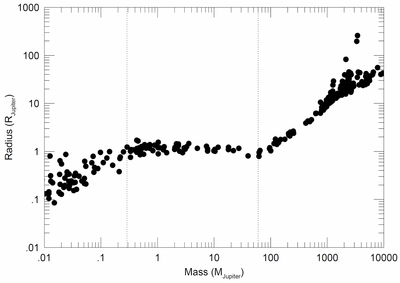
Hatzes & Rauer (2015), “A Definition for Giant Planets Based on the Mass-Density Relationship”, arXiv:1506.05097 [astro-ph.EP]
| Hydrogen | Atomic radius |
g/cm3 | Jupiter volume |
g's |
|---|---|---|---|---|
| Liquid | 1 | 0.07085 | 0.053 MJup | 0.14 |
| Metallic | 1/ 4 | 4.5344 | 3.400 MJup | 9.00 |
| Double | 1/ 5.657 | 12.8250 | 9.669 MJup | 25.56 |
| Triple | 1/ 8 | 36.2752 | 27.300 MJup | 72.16 |
| Quadruple | 1/ 11.31 | 102.6 | 77.350 MJup | 204.40 |
| Quintuple | 1/ 16 | 290.2016 | 219.000 MJup | 578.80 |
| Sextuple | 1/ 22.63 | 820.8140 | 618.800 MJup | 1636.00 |
As can be seen in the image to the right, all planets (Brown dwarfs) from 1 to 100 Jupiter masses are about 1 Jupiter radius which is 69,911 km. The largest "puffy" planets are 2 Jupiter radii. 1 Jupiter volume = 1.431×1015 km3
This suggests that the pressure an electron shell (in degenerate matter) can withstand without again becoming degenerate (*Electron degeneracy pressure) is inversely proportional to the sixth power of its radius:
(This formula only applies to degenerate matter like metallic hydrogen. Non-degenerate matter can withstand far more pressure).
If so then the maximum size (radius) that a planet composed entirely of one (degenerate) element could grow would depend only on, and be inversely proportional to, the atomic mass of its atoms. (Use 2 for the atomic mass of diatomic hydrogen).
Simplified calculation of radius of brown dwarf as core grows from zero to 1 Jupiter radius:
- r is radius of core with 2.83 (sqrt(2)3) times the density of overlying material
Rock floats on top of the metallic hydrogen but iron sinks to the Core. 0.1% of the mass of the brown dwarf is iron. Assuming iron density of 231.85 g/cm3 (as in Earths core), the gravity of the iron core will cause the brown dwarf to be about 3% smaller then it would be otherwise.
Dark matter[]
Dark matter is a type of unidentified matter that may constitute about 80% of the total matter in the universe. It has not been directly observed, but its gravitational effects are evident in a variety of astrophysical measurements. The primary evidence for dark matter is that calculations show that many galaxies would fly apart instead of rotating if they did not contain a large amount of matter beyond what can be observed.
From Wikipedia:Gravitational microlensing

An Einstein ring.

Microlensing allows the study of objects that emit little or no light. With microlensing, the lens mass is too low for the displacement of light to be observed easily, but the apparent brightening of the source may still be detected. In such a situation, the lens will pass by the source in seconds to years instead of millions of years.
The Einstein radius, also called the Einstein angle, is the angular radius of the Einstein ring in the event of perfect alignment. It depends on the lens mass M, the distance of the lens dL, and the distance of the source dS:
- (in radians).
For M equal to 60 Jupiter masses, dL = 4000 parsecs, and dS = 8000 parsecs (typical for a Bulge microlensing event), the Einstein radius is 0.00024 arcseconds (angle subtended by 1 au at 4000 parsecs). By comparison, ideal Earth-based observations have angular resolution around 0.4 arcseconds, 1660 times greater. One parsec is equal to about 3.26 light-years (30 trillion km).
Any brown dwarf surrounded by a circumstellar disk larger and thicker than 1 au would therefore be virtually completely undetectable.
Stars[]
- See also: *Stellar evolution, *Helium flash, *Schönberg–Chandrasekhar limit, Coronal_heating_problem

Image of spiral galaxy *M81.

Explanation of spiral galaxy arms.
Fusion of diatomic hydrogen begins around 60 Jupiter masses. Fusion of monatomic helium requires significantly more pressure.
Fusion releases energy that heats the star causing it to expand. The expansion reduces the pressure in the core which reduces the rate of fusion. So the rate of fusion is self limiting. A low mass star has a lifetime of billions of years. A high mass star has a lifetime of only a few tens of millions of years despite starting with more hydrogen.
Low mass stars are far more common than high mass stars. The masses of the two component stars of NGC 3603-A1, A1a and A1b, determined from the orbital parameters are 116 ± 31 M☉ and 89 ± 16 M☉respectively. This makes them the two most massive stars directly measured, i.e. not estimated from models.
The luminousity of a star is:
- where σ is the *Stefan–Boltzmann constant:
The luminosity of the sun at 5772 K and 695,700 km is 3.828×10^26 Watts
- Thats 6,297,000 watts/m2
The brightness of sunlight at the surface of the Earth is 1400 watt/meter2
The plasma inside a star is non-relativistic. A relativistic plasma with a thermal *distribution function has temperatures greater than around 260 keV, or *3.0 * 109 K. Those sorts of temperatures are only created in a supernova. The core of the sun is about 15 * 106 K.
Plasmas, which are normally opaque to light, are transparent to light with frequency higher than the *plasma frequency. The plasma literally cant vibrate fast enough to keep up with the light. Plasma frequency is proportional to the square root of the electron density.
- where
- ne = number of electrons / volume.
See also: *Bremsstrahlung#Thermal_bremsstrahlung
From 0.3 to 1.2 solar masses, the region around the stellar core is a radiative zone. (The light frequency is higher than the plasma frequency). The radius of the radiative zone increases monotonically with mass, with stars around 1.2 solar masses being almost entirely radiative.
From Wikipedia:Convective zone
In main sequence stars of less than about 1.3 solar masses, the outer envelope of the star contains a region of relatively low temperature which causes the frequency of the light to be lower than the plasma frequency which causes the opacity to be high enough to produce a steep temperature gradient. This produces an outer convection zone. The Sun's convection zone extends from 0.7 solar radii (500,000 km) to near the surface.
From Wikipedia:Cepheid variable
A Cepheid variable is a type of star that pulsates radially, varying in both diameter and temperature and producing changes in brightness with a well-defined stable period and amplitude.
A strong direct relationship between a Cepheid variable's luminosity and pulsation period allows one to know the true luminosity of a Cepheid by simply observing its pulsation period. This in turn allows one to determine the distance to the star, by comparing its known luminosity to its observed brightness.
The pulsation of cepheids is known to be driven by oscillations in the ionization of helium. From fully ionized (more opaque) He++ to partially ionized (more transparent) He+ and back to He++. See *Kappa mechanism.
In the swelling phase. Its outer layers expand, causing them to cool. Because of the decreasing temperature the degree of ionization also decreases. This makes the gas more transparent, and thus makes it easier for the star to radiate its energy. This in turn will make the star start to contract. As the gas is thereby compressed, it is heated and the degree of ionization again increases. This makes the gas more opaque, and radiation temporarily becomes captured in the gas. This heats the gas further, leading it to expand once again. Thus a cycle of expansion and compression (swelling and shrinking) is maintained.
From Wikipedia:Instability strip
In normal A-F-G stars He is neutral in the stellar photosphere. Deeper below the photosphere, at about 25,000–30,000K, begins the He II layer (first He ionization). Second ionization (He III) starts at about 35,000–50,000K.
| Recombination and Reionization |
|---|
|
The first phase change of hydrogen in the universe was recombination due to the cooling of the universe to the point where electrons and protons form neutral hydrogen. The universe was opaque before the recombination, due to the scattering of photons (of all wavelengths) off free electrons, but it became increasingly transparent as more electrons and protons combined to form neutral hydrogen atoms. The Dark Ages of the universe start at that point, because there were no light sources. The second phase change occurred once objects started to condense in the early universe that were energetic enough to re-ionize neutral hydrogen. As these objects formed and radiated energy, the universe reverted to once again being an ionized plasma. (See *Warm–hot intergalactic medium). At this time, however, matter had been diffused by the expansion of the universe, and the scattering interactions of photons and electrons were much less frequent than before electron-proton recombination. Thus, a universe full of low density ionized hydrogen will remain transparent, as is the case today. |
The Sun's photosphere has a temperature between 4,500 and 6,000 K. Negative hydrogen ions (H-) are the primary reason for the highly opaque nature of the photosphere.
As the star fuses hydrogen into heavier elements the heavier elements build up in the core. Eventually the outer layers of the star are blown away and all thats left is the core. We call whats left a white dwarf.

A plot of 22000 stars from the Hipparcos Catalogue together with 1000 low-luminosity stars (red and white dwarfs) from the Gliese Catalogue of Nearby Stars. The ordinary hydrogen-burning dwarf stars like the Sun are found in a band running from top-left to bottom-right called the Main Sequence. Giant stars form their own clump on the upper-right side of the diagram. Above them lie the much rarer bright giants and supergiants. At the lower-left is the band of white dwarfs.
White dwarfs[]
| *Z | *A | Element | (ppm) | g/cm3 | g/cm3 | radius |
|---|---|---|---|---|---|---|
| 1 | 1 | *Hydrogen | 739,000 | 0.07085 | 290.2 | 71,492 |
| 1 | 2 | *Deuterium | 100 | 0.1417 | 580.4 | 35,746 |
| 2 | 4 | *Helium | 240,000 | 0.125 | 512 | 35,746 |
| 4 | 8 | *Beryllium | 0 | 2 | 8,192 | 17,873 |
| 8 | 16 | *Oxygen | 10,400 | 32 | 131,072 | 8,936 |
| 6 | 12 | *Carbon | 4,600 | 10.125 | 41,472 | 11,915 |
| 10 | 20 | *Neon | 1,340 | 78.125 | 320,000 | 7,149 |
| 26 | 56 | *Iron-56 | 1,090 | 4358 | 15,748,096 | 2,553 |
| 7 | 14 | *Nitrogen | 960 | 18.76 | 76,841 | 10,213 |
| 14 | 28 | *Silicon | 650 | 300.125 | 1,229,312 | 5,107 |
| 12 | 24 | *Magnesium | 580 | 162 | 663,552 | 5,958 |
| 16 | 32 | *Sulfur | 440 | 512 | 2,097,152 | 4,468 |
| 1H 2D | ||||||
| H | + | H | = | 2D | ||
| D | + | D | = | 4He | ||
| 4He | ||||||
| He | + | He | = | Unstable | ||
| He | × | 3 | = | 12C | ||
| He | + | C | = | 16O | ||
| 12C | ||||||
| C | + | C | = | 24Mg | ||
| C | + | O | = | 28Si | ||
| 16O | ||||||
| O | + | O | = | 32S | ||
| O | + | Mg | = | 40Ca | ||
| 24Mg | ||||||
| Mg | + | S | = | 56Fe | ||
| 28Si 32S | ||||||
| Si | + | Si | = | 56Fe | ||
| Si | + | S | = | 60Ni | ||
| S | + | S | = | 64Zn | ||
| 56Fe 60Ni | ||||||
| 14N and 20Ne are produced when the outer layers become convective. 8Be, 18F, and 26Al are unstable. | ||||||
A white dwarf is about the same size as the Earth but is far denser and far more massive. A typical temperature for a white dwarf is 25,000 K. That would make its surface brightness 350 times the surface brightness of the sun.
Simplified calculation of radius of White dwarf as core grows from zero to half the original radius:
- r is radius of core. The core has 16 times the density (twice the atomic number) of the overlying material. The final state has half the radius and twice the mass of the original white dwarf.
A 0.6 solar mass White dwarf is 8900 km in radius which Is 8.03 times smaller than Jupiter which suggests a composition of oxygen. It has a surface gravity of
Its density is 404,000 g/cm3 which is 12,625 times denser than oxygen in its ground state. Thats 23.2853 times denser. Sqrt(2)9 = 22.63
A 1.13 solar mass White dwarf is 4500 km in radius which Is 15.9 times smaller than Jupiter which suggests a composition of sulfur. It has a surface gravity of
Its density is 5.887 * 106 g/cm3 which is 11,498 times denser than sulfur in its ground state. Thats 22.573 times denser.
For a white dwarf made of iron:
- Radius: 2,553 km
- Surface area: 8.2*107 km2
- Mass per surface area: 3.8 * 1013 g/mm2
- Mass: 4.454 * 107 g/cm3 * (4/3)*pi*(2553 km)3 in solar masses = 1.56 solar masses.
- Surface gravity: 3.24 * 106 g's
- Density: (sqrt(2)9)3 * 3844.75 g/cm3 = 4.454 * 107 g/cm3
- Core pressure: 1.8 * 1019 bars
The core of a white dwarf with a mass greater than the *Chandrasekhar limit (1.44 solar masses) will undergo gravitational collapse and become a neutron star.
Back to top
Neutron stars[]
- See also: *Gravitoelectromagnetism
Assuming a solid honeycomb array of neutron pairs with radius 1 fm, a sheet of *neutronium (if such a thing existed) would have a density of 1.2893598 g/mm2.
Density of a liquid neutron star made of neutron pairs with radius 1 fm would be 479.8×1012 g/cm3
The maximum observed mass of neutron stars is about 2.01 M☉.
At that density a 2 solar mass neutron star would have a radius of 12.5544 km
Its gravitational binding energy would be 0.282 solar masses of energy
The *Tolman–Oppenheimer–Volkoff limit (or TOV limit) is an upper bound to the mass of cold, nonrotating neutron stars, analogous to the Chandrasekhar limit for white dwarf stars. Observations of GW170817 suggest that the limit is close to 2.17 solar masses.
The equation of state for a neutron star is not yet known.
A 2 solar mass neutron star with radius of 12.5544 km would have a surface gravity of:
The pressure in its core would be 5.072 * 1028 bar = 5.071 * 1028 bar
Its moment of inertia is: 0.4*2 solar masses*(12.5544 km)^2 = 2.507×10^38 kg m^2
From Wikipedia:Glitch (astronomy)
A glitch (See *Global_resurfacing_event) is a sudden increase of up to 1 part in 106 in the rotational frequency of a rotation-powered pulsar. Following a glitch is a period of gradual recovery, lasting 10-100 days, where the observed periodicity slows to a period close to that observed before the glitch.
If mass is constant then
If angular momentum is constant then
The moment of inertia of a solid crust 1 cm thick is: 0.666*((1.2*479.8×10^12 g/cm3)*1 cm*4*pi*(12.5544 km)^2)*(12.5544 km)^2 = 1.197×10^33 kg m^2. Thats 1/209,440 of the total moment of inertia. 1 cm doesn't seem like much but if each Neutron were the size of an atom then that one centimeter would be one or two km.
External link: Pulsar glitches and their impact on neutron-star astrophysics
From Wikipedia:Supermassive black hole
A supermassive black hole (SMBH or SBH) is the largest type of *black hole, on the order of hundreds of thousands to billions of *solar masses (M☉), and is found in the centre of almost all currently known massive galaxies.
The mass of the SMBH in a galaxy is often close to the combined mass of the galaxy's globular clusters.
The mean ratio of black hole mass to bulge mass is now believed to be approximately 1:1000.
- The most massive galaxy known is 30 trillion solar masses.
Some supermassive black holes appear to be over 10 billion solar masses.
From Wikipedia:Quasar:
A quasar is an active galactic nucleus of very high luminosity. A quasar consists of a supermassive black hole surrounded by an orbiting accretion disk of gas. The most powerful quasars have luminosities exceeding 2.6×1014 ℒ☉ (1041 W or 17.64631 M☉/year), thousands of times greater than the luminosity of a large galaxy such as the Milky Way.
Growing at a rate of 17.6/1.4^2 solar mass per year a 60 billion solar mass Black hole would take 6.66 billion years to reach full size. See *TON 618
Growing at a rate of 17.6/2.8^2 solar mass per year a 240 billion solar mass Black hole would take 107 billion years to reach full size.
Masses of supermassive black holes in billions of solar masses:
- 240? (Hypothetical based on Zipf's law)
- 120? (Hypothetical)
- 80? (Hypothetical)
- 66
- 40
- 33
- 30
- 23
- 21
- 20
- 19.5
- 18
- 17
- 15
- 14
- 14
- 13.5
- 13
- 12
- 12.4
- 11
- 11
- 10
- 10
- 9.8
- 9.7
- 9.1
- 7.8
- 7.2
- 7.2
- 6.9
From Wikipedia:Eddington luminosity
The Eddington luminosity, also referred to as the Eddington limit, is the maximum luminosity a body (such as a star) can achieve when there is balance between the force of radiation acting outward and the gravitational force acting inward. The state of balance is called hydrostatic equilibrium. When a star exceeds the Eddington luminosity, it will initiate a very intense radiation-driven stellar wind from its outer layers.
For pure ionized hydrogen
where is the mass of the Sun and is the luminosity of the Sun.
Gamma-ray bursts[]

From Wikipedia:Gamma-ray burst
Gamma-ray bursts (GRBs) are extremely energetic explosions that have been observed in distant galaxies. They are the brightest electromagnetic events known to occur in the universe. Bursts can last from ten milliseconds to several hours. After an initial flash of gamma rays, a longer-lived "afterglow" is usually emitted at longer wavelengths (X-ray, ultraviolet, optical, infrared, microwave and radio).
Assuming the gamma-ray explosion to be spherical, the energy output of *GRB 080319B would be within a factor of two of the rest-mass energy of the Sun (the energy which would be released were the Sun to be converted entirely into radiation).
No known process in the universe can produce this much energy in such a short time.
GRB 111209A is the longest lasting gamma-ray burst (GRB) detected by the Swift Gamma-Ray Burst Mission on December 9, 2011. Its duration is longer than 7 hours.
On average two long gamma ray burst occurs every 3 days and have average redshift of 2. Making the simplifying assumption that all long gamma ray bursts occur at exactly redshift 2 (9.2 * 109 light years) we get one gamma ray burst per (1,635,000 light years)3
There are 12 galaxies per cubic megaparsec. Thats 1 galaxy per (1,425,000 light years)3
One short grb per 3 days at average redshift of 0.5 (4.6 * 109 light years) gives 1 grb per (1,300,000 light years)3
| ||||||||||||||||||||||||||||||||||||||||||||||||||
| Surface gravity = 29.6 g's, Density = 3.461099×108 g/mm^2 | ||||||||||||||||||||||||||||||||||||||||||||||||||
Ultra-high-energy Cosmic rays[]
External links: http://hires.physics.utah.edu/reading/uhecr.html, The cosmic ray energy spectrum as measured using the Pierre Auger Observatory
The highest energy gamma rays ever detected from space were around 16 TeV which corresponds to a wavelength of 1/13,000 fm.
From Wikipedia:Cosmic ray
*Cosmic rays are high-energy radiation, mainly originating outside the Solar System and even from distant galaxies. Upon impact with the Earth's atmosphere, cosmic rays can produce showers of secondary particles that sometimes reach the surface. Composed primarily of high-energy protons and atomic nuclei, they are of uncertain origin. Data from the Fermi Space Telescope (2013) have been interpreted as evidence that a significant fraction of primary cosmic rays originate from the supernova explosions of stars. Active galactic nuclei are also theorized to produce cosmic rays.
From Wikipedia:Ultra-high-energy cosmic ray
In *astroparticle physics, an ultra-high-energy cosmic ray (UHECR) is a cosmic ray particle with a kinetic energy greater than than 1×1018 *eV, far beyond both the *rest mass and energies typical of other cosmic ray particles.
An extreme-energy cosmic ray (EECR) is an UHECR with energy exceeding 5×1019 eV (about 8 joule), the so-called *Greisen–Zatsepin–Kuzmin limit (GZK limit). This limit should be the maximum energy of cosmic ray protons that have traveled long distances (about 160 million light years), since higher-energy protons would have lost energy over that distance due to scattering from photons in the *cosmic microwave background (CMB). However, if an EECR is not a proton, but a nucleus with nucleons, then the GZK limit applies to its nucleons, each of which carry only a fraction of the total energy.
These particles are extremely rare; between 2004 and 2007, the initial runs of the *Pierre Auger Observatory (PAO) detected 27 events with estimated arrival energies above 5.7×1019 eV, i.e., about one such event every four weeks in the 3000 km2 area surveyed by the observatory.
At that rate 5.46 * 1018 particles will fall onto a star with radius 1 million kilometers every hundred million years.
From Wikipedia:Oh-My-God particle:
The Oh-My-God particle was an ultra-high-energy cosmic ray detected on the evening of 15 October 1991 by the Fly's Eye Cosmic Ray Detector. Its observation was a shock to astrophysicists, who estimated its energy to be approximately 3×1020 eV. It was probably a cluster of 6 ultra-high-energy cosmic ray particles.
mv2 = (205,887*128^2*2 neutron mass * (2.807*c)^2) = 5×1019 eV
Expansion of the universe[]
From Wikipedia:Expansion of the universe
The expansion of the universe is the increase of the distance between two distant parts of the universe with time.
The expansion of space is often illustrated with conceptual models. In the "balloon model" a spherical balloon is inflated from an initial size of zero (representing the big bang).
From Wikipedia:Scale factor (cosmology)
Some insight into the expansion can be obtained from a Newtonian expansion model which leads to a simplified version of the Friedman equation. It relates the proper distance (which can change over time, unlike the comoving distance which is constant) between a pair of objects, e.g. two galaxy clusters, moving with the Hubble flow in an expanding or contracting FLRW universe at any arbitrary time to their distance at some reference time . The formula for this is:
where is the proper distance at epoch , is the distance at the reference time and is the scale factor. Thus, by definition, .
The scale factor is dimensionless, with counted from the birth of the universe and set to the present age of the universe: giving the current value of as or .
The evolution of the scale factor is a dynamical question, determined by the equations of general relativity, which are presented in the case of a locally isotropic, locally homogeneous universe by the *Friedmann equations.
The Hubble parameter is defined:
where the dot represents a time derivative. From the previous equation one can see that , and also that , so combining these gives , and substituting the above definition of the Hubble parameter gives which is just Hubble's law.
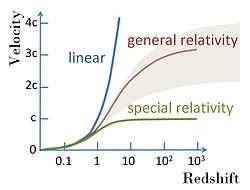
A variety of possible recessional velocity vs. redshift functions including the simple linear relation v = cz; a variety of possible shapes from theories related to general relativity; and a curve that does not permit speeds faster than light in accordance with special relativity. All curves are linear at low redshifts. See Davis and Lineweaver.
The discovery of the linear relationship between redshift and distance, coupled with a supposed linear relation between recessional velocity and redshift, yields a straightforward mathematical expression for Hubble's Law as follows:
where
- is the recessional velocity, typically expressed in km/s.
- H0 is Hubble's constant and corresponds to the value of (often termed the Hubble parameter which is a value that is *time dependent and which can be expressed in terms of the *scale factor) in the Friedmann equations taken at the time of observation denoted by the subscript 0. This value is the same throughout the Universe for a given comoving time.
- is the proper distance (which can change over time, unlike the comoving distance, which is constant) from the galaxy to the observer, measured in mega parsecs (Mpc), in the 3-space defined by given cosmological time. (Recession velocity is just v = dD/dt).
Hubble's law is considered a fundamental relation between recessional velocity and distance. However, the relation between recessional velocity and redshift depends on the cosmological model adopted, and is not established except for small redshifts.
For distances D larger than the radius of the Hubble sphere rHS , objects recede at a rate faster than the speed of light:
Its radius is the Hubble radius and its volume is the Hubble volume.
The Hubble constant has units of inverse time; the Hubble time tH is simply defined as the inverse of the Hubble constant, i.e. = 14.4 billion years. The Hubble time is the age it would have had if the expansion had been linear.
The value of the Hubble parameter changes over time, either increasing or decreasing depending on the value of the so-called deceleration parameter , which is defined by
In a universe with a deceleration parameter equal to zero, it follows that H = 1/t, where t is the time since the Big Bang.
The age of the universe is thought to be 13.8 billion years.
1/13.8 billion years = 70.9 (km/s)/Mpc
Weather[]
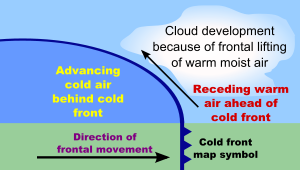
- Main article: Weather
A cold front is the leading edge of a cold dense mass of air, replacing (at ground level) a warmer mass of air. Like a hot air balloon, the warm air rises above the cold air. The rising warm air expands and therefore cools. This causes the moisture within it to condense into droplets and releases the latent heat of condensation which causes the warm air to rise even further. If the warm air is moist enough, rain can occur along the boundary. A narrow line of thunderstorms often forms along the front. Temperature changes across the boundary can exceed 30 °C (54 °F).

An idealised view of three large circulation cells showing surface winds
The polar front is a cold front that arises as a result of cold polar air meeting warm subtropical air at the boundary between the polar cell and the Ferrel cell in each hemisphere.
Earth's weather is primarily driven by rising air in three Low-pressure areas.
- The northern hemisphere polar front.
- Extratropical cyclones form along the front and move eastward at 12-15 m/s (43-54 km/h) and last 3-5 days. (3600-6000 km)
- The Intertropical Convergence Zone. Sometimes, a double ITCZ forms, with one north and one south of the Equator.
- Tropical cyclones (Hurricanes) form here and move westward.
- The southern hemisphere polar front.
- Extratropical cyclones form along the front and move eastward

Tropical air is far warmer than air outside the tropics and therefore holds far more moisture and as a result thunderstorms in the tropics are much taller. Nevertheless severe thunderstorms are not common in the tropics because the storms own downdraft shuts off the inflow of warm moist air killing the thunderstorm before it can become severe. Severe thunderstorms tend to occur further north because of the polar jet stream. The jet stream pushes against the top of the thunderstorm displacing the downdraft so that it can no longer shut off the inflow of warm moist air. As a result severe thunderstorms can continue to feed and grow for many hours whereas normal thunderstorms only last 30 minutes.
Over a 30 minute period a normal thunderstorm releases 1015 Joules of energy equivalent to 0.24 megatons of TNT. A storm that lasted 24 hours would release 48 times as much energy (48 x 1015 Joules). A hurricane (a tropical cyclone) releases 52 x 1018 Joules/day equivalent to 1000 continuous thunderstorms.
Scale height is the increase in altitude for which the atmospheric pressure decreases by a factor of e. The scale height remains constant for a particular temperature. It can be calculated by
- where:
- k = *Boltzmann constant = 1.38 x 10−23 J·K−1
- T = mean atmospheric temperature in kelvins = 250 K for Earth
- M = mean mass of a molecule (units kg)
- g = acceleration due to gravity on planetary surface (m/s²)
Approximate atmospheric scale heights for selected Solar System bodies follow.
- Venus: 15.9 km
- Earth: 8.5 km
- Mars: 11.1 km
- Jupiter: 27 km
- Saturn: 59.5 km
- Titan: 21 km
- Uranus: 27.7 km
- Neptune: 19.1–20.3 km
- Pluto: ~60 km
If all of Earths atmosphere were at 1 bar then the atmosphere would be 8.5 km thick.
See also:
Life[]
- External link: Molecular biology of the cell
Did life begin with *nucleic acids or amino acids? Maybe it began with a molecule that was both a nucleic acid and an amino acid.
3-Aminobenzoic-acid:
Creating the monomers in the *Primordial soup is easy but getting the monomers to bond into a polymer is hard. So maybe it wasnt a polymer at all. Maybe it was a one dimensional liquid crystal. See *Mesogen.
Unexplained phenomena[]
Books published by *William R. Corliss include:
- Mysteries of the Universe (1967)
- Mysteries Beneath the Sea (1970)
- Strange Phenomena: A Sourcebook of Unusual Natural Phenomena (1974)
- Strange Artifacts: A Sourcebook on Ancient Man (1974)
- The Unexplained (1976)
- Strange Life (1976)
- Strange Minds (1976)
- Strange Universe (1977)
- Handbook of Unusual Natural Phenomena (1977)
- Strange Planet (1978)
- Ancient Man: A Handbook of Puzzling Artifacts (1978)
- Mysterious Universe: A Handbook of Astronomical Anomalies (1979)
- Unknown Earth: A Handbook of Geological Enigmas (1980)
- Incredible Life: A Handbook of Biological Mysteries (1981)
- The Unfathomed Mind: A Handbook of Unusual Mental Phenomena (1982)
- Lightning, Auroras, Nocturnal Lights, and Related Luminous Phenomena (1982)
- Tornados, Dark Days, Anomalous Precipitation, and Related Weather Phenomena (1983)
- Earthquakes, Tides, Unidentified Sounds, and Related Phenomena (1983)
- Rare Halos, Mirages, Anomalous Rainbows, and Related Electromagnetic Phenomena (1984)
- The Moon and the Planets (1985)
- The Sun and Solar System Debris (1986)
- Stars, Galaxies, Cosmos (1987)
- Carolina Bays, Mima Mounds, Submarine Canyons (1988)
- Anomalies in Geology: Physical, Chemical, Biological (1989)
- Neglected Geological Anomalies (1990)
- Inner Earth: A Search for Anomalies (1991)
- Biological Anomalies: Humans I (1992)
- Biological Anomalies: Humans II (1993)
- Biological Anomalies: Humans III (1994)
- Science Frontiers: Some Anomalies and Curiosities of Nature (1994)
- Biological Anomalies: Mammals I (1995)
- Biological Anomalies: Mammals II (1996)
- Biological Anomalies: Birds (1998)
- Ancient Infrastructure: Remarkable Roads, Mines, Walls, Mounds, Stone Circles: A Catalog of Archeological Anomalies (1999)
- Ancient Structures: Remarkable Pyramids, Forts, Towers, Stone Chambers, Cities, Complexes: A Catalog of Archeological Anomalies (2001)
- Remarkable Luminous Phenomena in Nature: A Catalog of Geophysical Anomalies (2001)
- Scientific Anomalies and other Provocative Phenomena (2003)
- Archeological Anomalies: Small Artifacts (2003)
- Archeological Anomalies: Graphic Artifacts I (2005)
Next section: Intermediate mathematics/Psychology
Search Math wiki[]
See also[]
External links[]
- MIT open courseware
- Cheat sheets
- http://mathinsight.org
- https://math.stackexchange.com
- https://www.eng.famu.fsu.edu/~dommelen/quantum/style_a/IV._Supplementary_Informati.html
- http://www.sosmath.com
- https://webhome.phy.duke.edu/~rgb/Class/intro_math_review/intro_math_review/node1.html
- Wikiversity:Mathematics
- w:c:4chan-science:Mathematics
References[]
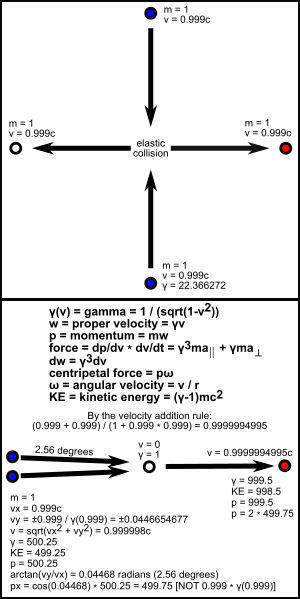
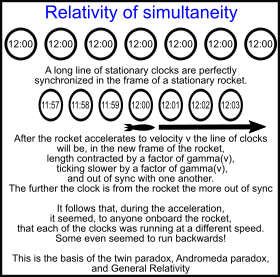








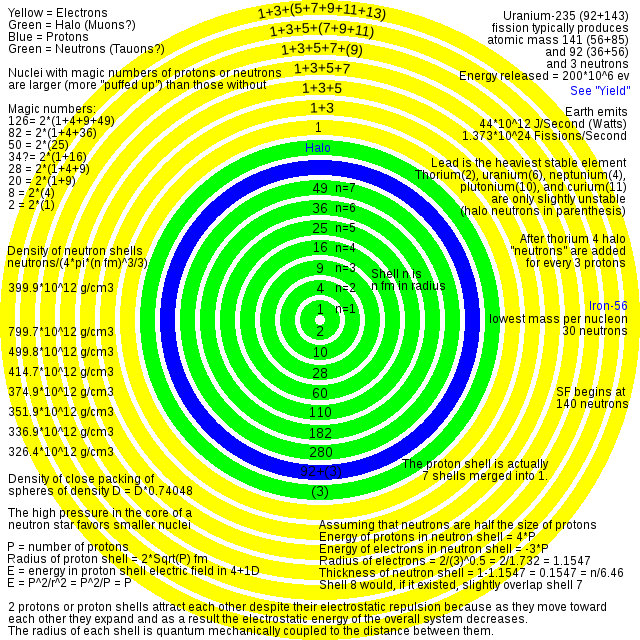


































![{\displaystyle {\sqrt[{3}]{G\cdot 1{\text{ Earth mass}}\cdot {\Bigg (}{\frac {4{\text{ hours}}}{2\pi }}{\Bigg )}^{2}}}}](https://services.fandom.com/mathoid-facade/v1/media/math/render/svg/01725f3ad17f43b7c6556cc82e97d4609dc756aa)

![{\displaystyle {\sqrt[{3}]{G\cdot 1{\text{ Solar mass}}{\Bigg (}{\frac {336.134453{\text{ days}}}{2\pi }}{\Bigg )}^{2}}}}](https://services.fandom.com/mathoid-facade/v1/media/math/render/svg/81f721e875fc6c0a27ed39d9452ce05b562b8a3c)


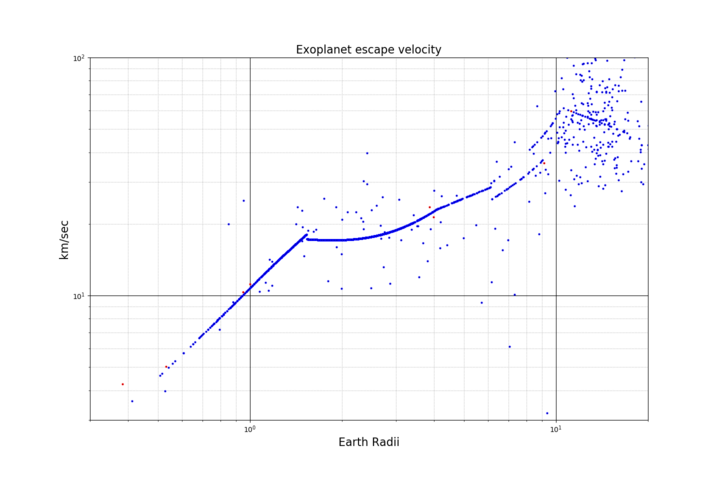












![{\displaystyle radius=1/{\sqrt[{3}]{density}}}](https://services.fandom.com/mathoid-facade/v1/media/math/render/svg/a99eba6d47beae43887bae45afe52feed5080ae2)
![{\displaystyle frequency=v/r=1/r^{2}=1/(1/{\sqrt[{3}]{density}})^{2}=density^{\frac {2}{3}}}](https://services.fandom.com/mathoid-facade/v1/media/math/render/svg/7ac69a6319e8986e462b400e4cf4cfc75756bd64)


































